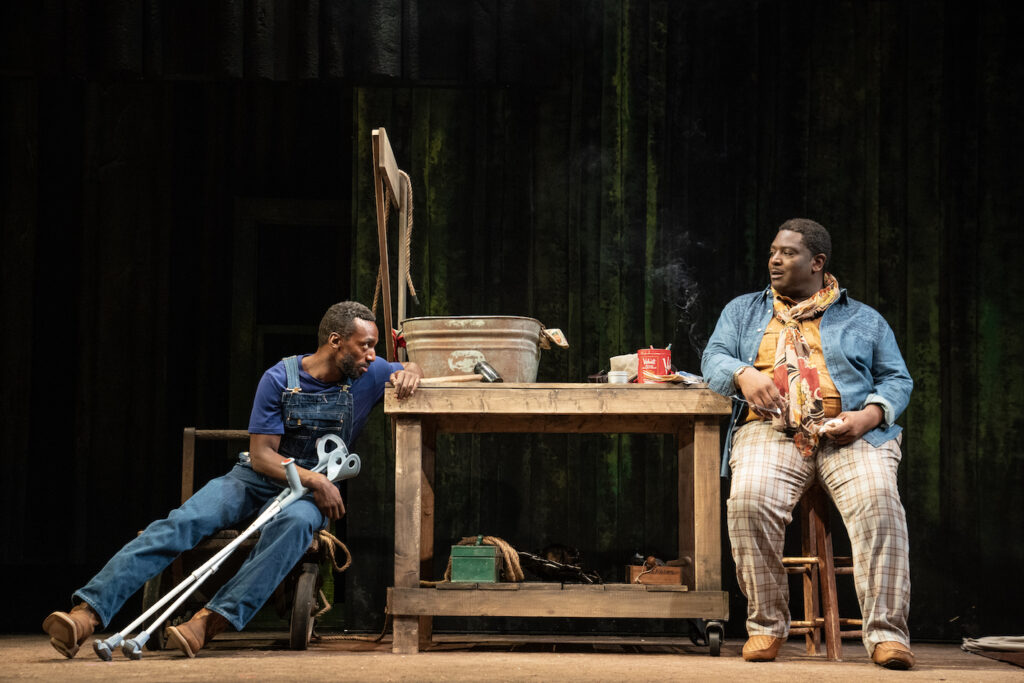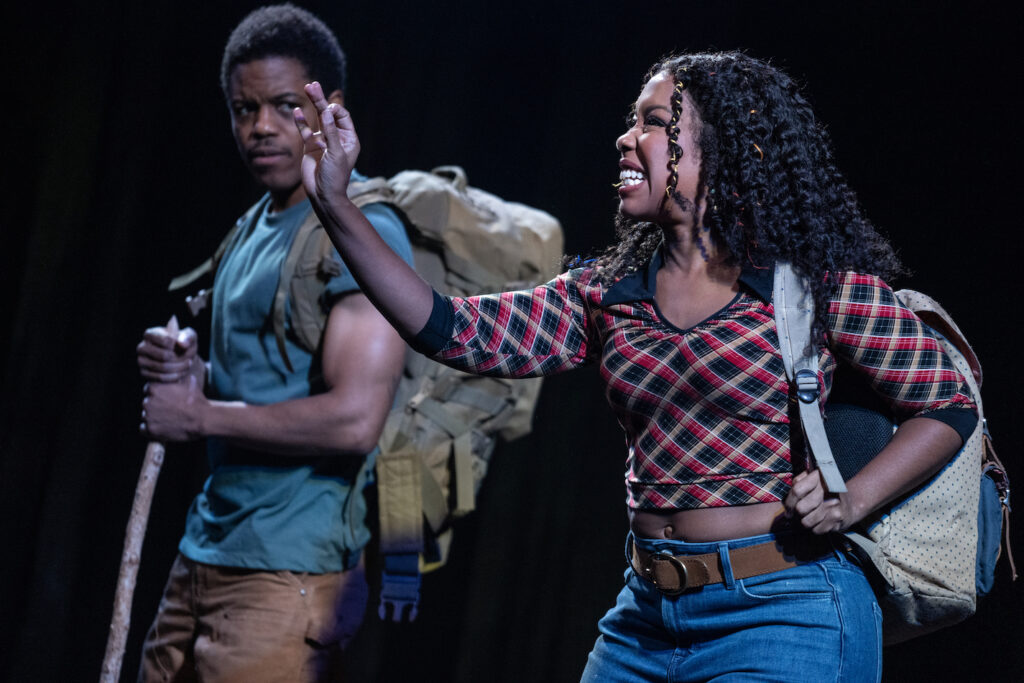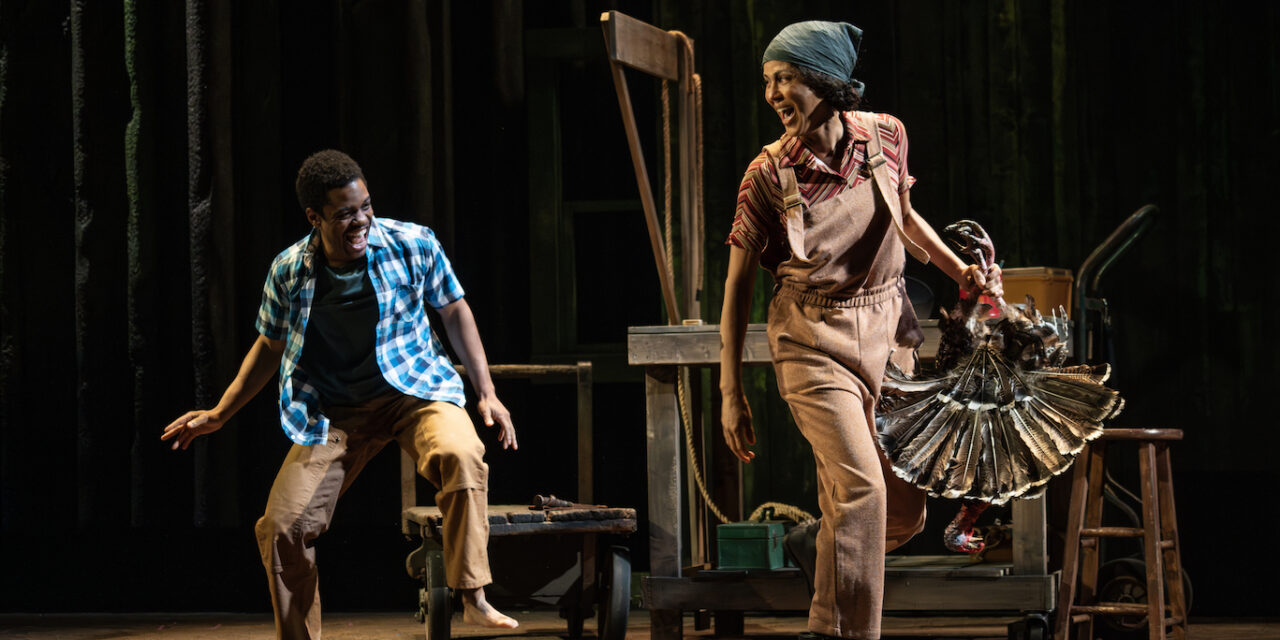By Carol Rocamora . . .
“You wanna be able to dream big, right?”
So said playwright Nathan Alan Davis in a recent interview regarding The Refuge Plays, his prodigious, powerful new work that just opened at the Roundabout Theatre in association with the New York Theatre Workshop. And no one could have described it better than the playwright himself.
Indeed, “dreaming big” is an understatement, when it comes to this rich and ambitious epic, featuring a three-part, three-hour-twenty-minute saga of a Black American family over a 70-year period, with an ensemble of ten actors playing characters from five generations—some real, some ghostly.

Set deep in the woods of southern Illinois, Part One of this three-part epic features the family today, isolated from reality in their refuge—a dwelling built by their own members generations ago. We first meet them at dawn, sleeping in the parlor. They feature a formidable female trio—Early (Nicole Ari Parker), the aged, fierce and former matriarch; Gail, her defensive daughter-in-law, now in charge (Jessica Frances Dukes); and Joy (Ngozi Anyanwu), Gail’s spirited daughter. These women from three generations are waited upon by Ha-Ha (JJ Wynder), Joy’s timid, teenage son. Humor enlivens their cozy refuge, as the trio spar amongst each other while discussing Ha-Ha’s need for a love life for the sake of the family’s future. Meanwhile, the ghost of Gail’s husband, Walking Man (Jon Michael Hill), appears in white (he’s also Early’s son), offering Gail a prophecy that she will die that night in an accident while driving the family truck (one of the connecting symbols in this three-part saga).
Ha-Ha eventually comes home (at the matriarchy’s behest) with a fetching young friend named Symphony (Mallori Taylor Johnson). Meanwhile, there’s another ghost—that of Crazy Eddie, Early’s husband (Daniel Watts)—who passes through the scene. Clearly, there’s a lot going on in Act One, and we’re charmed by the numerous characters, eager to discover what happens to them next. Will Ha-Ha and Symphony develop a relationship? Will Gail really die, as her husband’s ghost prophesizes?
But we don’t get the chance to find out. Instead, Playwright Davis confronts us with an unexpected challenge. He proceeds to tell the family story in reverse chronology instead, moving back into their past for the next two parts. It’s a bold choice that requires intense concentration on the part of a surprised audience, but ultimately it offers great dramatic rewards. Part Two goes back fifty years in time to the 1970s, focusing on the character of Walking Boy (the ghost from Act One, played marvelously by Hill) and his relationship with his mother Early (the amazing Nicole Ari Parker again, now 50 years younger). New characters in the family are also introduced, including Uncle Dax (Walking Boy’s Uncle, wonderfully played by Lance Coadie Williams, about whom we wish we could have learned more). There is also the unexpected cameo appearance of another pair of ghosts dressed in white from the family’s deep past—named Reginald (Jerome Preston Bates) and Clydette (Lizan Mitchell). They are Early’s parents, warning their daughter of things to come (namely, what’s going to be revealed in the third and final part about the family’s origins).


Part Three, set 20 years earlier in the 1950s, features an encounter between Crazy Eddie (powerfully performed by Watts) and young Early with her six-month-old baby Walking Man, alone in the Illinois woods. It’s a touching duet in stark contrast to the densely populated previous scenes, and it reveals the family’s source. These two young souls, seeking shelter from crises in their respective lives, unite in a shared commitment to build a house together that would become their family’s refuge for future generations. Hence the title of the play, and the beginning of the family story that takes three-plus hours to tell (in reverse).
In an interview, Davis explains that he wrote these plays in the order in which they were presented. I appreciate the playwright’s bravado in maintaining the reverse chronology for the production. It provides these marvelous actors with an opportunity to display their admirable skills—directed with generosity and heart by Patricia McGregor and brought to life on Arnulfo Maldonado’s lovingly imagined set of the family refuge in the woods.
And yet, I would have enjoyed it just as much had the story been told chronologically. That’s because Davis’s greatest accomplishment in The Refuge Plays lies in the creation of engaging, warm-blooded, intensely human characters for whom we come to care deeply. Early, who emerges as the play’s protagonist, is a larger-than-life figure, in the tradition of towering Black matriarchs in American dramatic literature like Mama in A Raisin in the Sun, fighting for survival as Suzan-Lori Parks’s female protagonists did in The Red Letter Plays. The charismatic Nicole Ari Parker gives a memorable performance in the role. As for the other characters, played so fully by this passionate and gifted ensemble, we only hope that Davis will continue to tell their stories, as other playwrights have done in expanded series of their own family plays—like Horton Foote did in his three-play Orphan’s Home Cycle set in Texas, or Richard Nelson did in his seven-part Apple Family Plays set in Rhinebeck, or Mfoniso Udofia is doing in her nine-play Ufot Cycle about a Nigerian-American family.


But what will Davis call these future plays, if he indeed chooses to write them? I ask because the family’s last name is notably absent in The Refuge Plays—unlike those in other great American family plays (e.g. Eugene O’Neill’s Tyrones in Long Day’s Journey into Night, or Arthur Miller’s Lomans in Death of a Salesman, or Lorraine Hansberry’s Youngers in A Raisin in the Sun, etc.). Is this intentional on Davis’s part? Is the playwright underscoring the idea of the family unit as separate from a historical setting, suspended in a kind of non-realistic context that transcends time? Is that why the play’s symbolism (the hammer, the water, the flame, the hunting for animals) also suggests an elemental universality and timelessness?
The characters in The Refuge on their journey through life are guided by spirits from their family’s past. Meanwhile, what about the playwright? My sense is that Nathan Alan Davis is also guided by a spirit. It’s that of August Wilson, that great American playwright and author of the Century Cycle of Black History in America. Like Wilson, Davis has the gift of writing mellifluous dialogue and creating rich, full, memorable characters—ones whom we long to meet again in future works.
Playwright Davis has indeed “dreamed big.” One hopes that he’ll keep on dreaming.
The Refuge Plays. Through November 12 at the Roundabout Theatre Company’s Laura Pels Theatre at the Harold and Miriam Steinberg Center for Theatre (111 West 46th Street, between Sixth and Seventh Avenues). Produced in association with the New York Theatre Workshop. www.roundabouttheatre.org
Photos: Joan Marcus


















